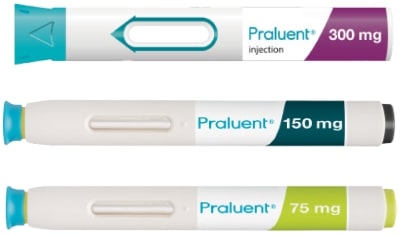- Article
- Source: Campus Sanofi
- 23 Jul 2025
NICE and SMC Guidance Praluent® (alirocumab)


NICE GUIDANCE
Alirocumab is recommended as an option for treating primary hypercholesterolaemia or mixed dyslipidaemia, only if LDL-C concentrations are persistently above the thresholds specified in the table below despite maximal tolerated lipid-lowering therapy1 and the company provides alirocumab with the discount agreed in the patient access scheme.
Table 1. Treatment groups and LDL-C thresholds for alirocumab prescribing (Adapted from NICE TA393)1
|
Patient populations |
Without CVD |
With CVD | |
|---|---|---|---|
|
High risk of CVD† |
Very high risk of CVD‡ | ||
|
Primary non-familial hypercholesterolaemia or mixed dyslipidaemia |
Not recommended at any LDL-C concentration |
Recommended only if LDL-C concentration is persistently above 4.0mmol/L |
Recommended only if LDL-C concentration is persistently above 3.5 mmol/L |
| Primary heterozygous-familial hypercholesterolaemia | Recommended only if LDL-C concentration is persistently above 5.0 mmol/L | Recommended only if LDL-C concentration is peristently above 3.5 mmol/L | |
NICE recommended lipid-lowering pathway
† High risk of cardiovascular disease is defined as a history of any of the following: acute coronary syndrome (such as myocardial infarction or unstable angina requiring hospitalisation), coronary or other arterial revascularisation procedures, coronary heart disease, ischaemic stroke, peripheral arterial disease.
‡ Very high risk of cardiovascular disease is defined as recurrent cardiovascular events or cardiovascular events in more than 1 vascular bed (that is, polyvascular disease).
Some patients with hypercholesterolaemia or mixed dyslipidaemia, including those with heterozygous familial hypercholesterolaemia (HeFH), do not reach NICE-recommended LDL-C goals despite lifestyle changes and maximal treatment with standard therapy (statins with or without ezetimibe)2-4
NICE did not make separate recommendations for patients with statin intolerance. NICE considered that people who cannot take statins may have higher than average LDL-C levels, and therefore may meet the LDL-C thresholds needed to start treatment with alirocumab.
NICE assessment
- The Technology Appraisal Guidance (TA393) for alirocumab was issued on 22 June 2016
SMC GUIDANCE
Alirocumab is a treatment option in adults with primary hypercholesterolaemia (heterozygous familial and non-familial) or mixed dyslipidaemia, as an adjunct to diet: in combination with a statin or statin with other lipid lowering therapies in patients unable to reach LDL-C goals with the maximum tolerated dose of a statin or, alone or in combination with other lipid-lowering therapies in patients who are statin-intolerant, or for whom a statin is contraindicated, with the following restrictions:
Alirocumab is for specialist use only in patients at high cardiovascular (CV) risk with LDL-C values as shown in Table 1 below.
Table 1. Treatment groups and LDL-C values for Praluent® prescribing in NHS Scotland
|
High risk patient group |
LDL-C threshold |
|
HeFH |
≥5.0mmol/L |
|
HeFH and prior CV event |
≥3.5mmol/L |
|
Previous CV events |
≥4.0mmol/L |
|
Recurrent/polyvascular events |
≥3.5mmol/L |
Table adapted from SMC 1147/16 (2016)5
SMC advice takes account of the benefits of a Patient Access Scheme (PAS) that improves the cost effectiveness of Praluent® and is contingent upon the continuing availability of the PAS in NHS Scotland or a list price that is equivalent or lower.
* LDL-C concentrations must be persistently above defined thresholds
Praluent®
Find more information on Indication, Administration and Mechanism of Action and watch videos about Praluent®.

.jpg)
References
Abbreviations: CVD, cardiovascular disease; LDL-C, low-density lipoprotein cholesterol.
1. NICE (2016). Technology Appraisal Guidance (TA393). Available at https://www.nice.org.uk/guidance/ta393. Accessed July 2025.
2. NICE (2015). Clinical Guideline (CG181) Cardiovascular disease: risk assessment and reduction, including lipid modification. Available at https://www.nice.org.uk/guidance/cg181. Accessed July 2025.
3. NICE (2008). Clinical Guideline (CG71) Familial hypercholesterolaemia: identification and management. Available at https://www.nice.org.uk/guidance/cg71. Accessed July 2025.
4. NICE. Technology appraisal guidance TA385. Ezetimibe for treating primary heterozygous-familial and non-familial hypercholesterolaemia. 2016. Available at https://www.nice.org.uk/guidance/ta385. Accessed July 2025.
5. SMC (2016). Alirocumab 75 mg and 150 mg solution for injection in pre-filled pen (Praluent) (SMC No. 1147/16).
MAT-XU-2503027 (v1.0) Date of Preparation: July 2024